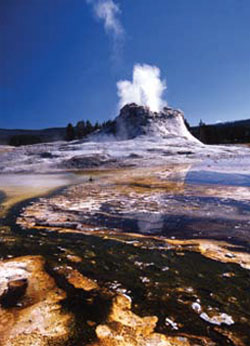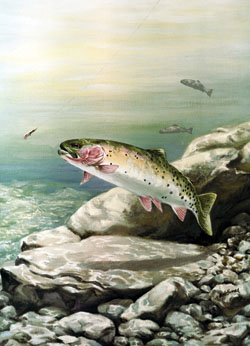Montana: Stories of the Land
Companion Website and Online Teacher's Guide
Chapter 4 - Newcomers Explore the Region, 1742-1827
Chapter 1 - Montana: Where the Land Writes History
Chapter 2 - People of the Dog Days
Chapter 3 - From Dog Days to Horse Warriors
Chapter 4 - Newcomers Explore the Region
Chapter 5 - Beaver, Bison, and Black Robes
Chapter 6 - Montana's Gold and Silver Boom
Chapter 7 - Two Worlds Collide
Chapter 8 - Livestock and the Open Range
Chapter 9 - Railroads Link Montana to the Nation
Chapter 10 - Politics and the Copper Kings
Chapter 11 - The Early Reservation Years
Chapter 12 - Logging in the "High Lonesome"
Chapter 13 - Homesteading This Dry Land
Chapter 14 - Towns Have Lives, Too
Chapter 15 - Progressive Montana
Chapter 16 - Montana and World War I
Chapter 17 - Montanans on the Move
Chapter 18 - The Great Depression Transforms Montana
Chapter 19 - World War II in Montana
Chapter 20 - Building a New Montana
Chapter 21 - A People's Constitution
Chapter 22 - Living in a New Montana
Educator Resources
Manifest Destiny
This chapter introduces the term "Manifest Destiny." In fact, the term was not used until after 1845, when newspaper editor John O'Sullivan coined the phrase. However, the idea captured by that phrase (that Americans had a special destiny to extend civilization across the continent) is much older than the phrase itself. Long before 1845, the ideology encapsulated in the term "Manifest Destiny" provided a philosophical rationale for westward expansion, which included the Louisiana Purchase. If you wish to extend the conversation on Manifest Destiny, you might consider having students analyze John Gast's 1872 print, American Progress. That image, reproduced on page 132 of the textbook, encapsulates nineteenth-century Euro-American ideas about westward expansion. See the OPI model IEFA lesson plan on the subject.
Indian Perspectives on European Exploration
The theme of European exploration provides a great opportunity to talk about point of view. Historians often talk about "Lewis and Clark meeting the Indians." What changes if you talk about "the Indians meeting Lewis and Clark"? Older textbooks celebrated the Corps of Discovery; more recently, Indian writers have pointed out that everything the European explorers encountered had been "discovered" thousands of years earlier. Traditional (Eurocentric) perspectives on the Age of Exploration are easy to find. More difficult to find is material written from tribal perspectives. Here are some good starting points.
The Regional Learning Project's website, trailtribes.org, offers "history with a tribal perspective along trails followed by Lewis and Clark." The Newberry Library's virtual exhibit, Lewis and Clark and the Indian Country: 200 Years of American History, also offers Indian perspectives, including interviews with tribal members on various topics related to the expedition.
The National Geographic Society has created a study resource collection, "Westward Expansion."
For a Salish perspective, see the The Salish People and the Lewis and Clark Expedition, by Salish-Pend d'Oreille Culture Committee, Elders Cultural Advisory Council and Confederated Salish and Kootenai Tribes (Lincoln: University of Nebraska Press, 2005).
Another interesting book is Lewis and Clark through Indian Eyes: Nine Indian Writers on the Legacy of the Expedition, by Alvin M. Josephy, Jr. (New York: Knopf, 2006).
The Other Explorers
While Lewis and Clark have dominated the American imagination, other explorers were equally important. Pathfinders and Passageways: The Exploration of Canada contains information on David Thompson and Alexander Mackenzie. Good David Thompson information can be found on in the Archives of Ontario's online David Thompson exhibit.
Educational Trunks
-
Discover the Corps of Discovery: The Lewis and Clark Expedition in Montana from the Montana Historical Society. This trunk, which traces the Corps' journey through Montana and their encounters with American Indians, includes bison and grizzly hides, trade goods, books, artist renditions of the expedition, a compass, and other relevant artifacts.
Takeaways
Inspired by reading specialist Tammy Elser, who was in turn inspired by SKC graduate Taylor Crawford, we've created a "Takeaway" bookmark for every chapter of Montana: Stories of the Land. Before starting a chapter, print and cut out these bookmarks and distribute them to your students. Ask them to use the Takeaway to summarize the GIST of what they learn from reading assigned sections of the chapter. Remind them that they don't have much room, so they'll need to think before they write down the most important idea they want to take away from the section. Learn a little more about the GIST strategy.
Even though we've created Takeaways for every chapter, we don't recommend you have your students complete a Takeaway for every section of every chapter they read. That would be exceedingly tedious. However, used appropriately, they can be a useful tool for encouraging reflection and teaching students how to summarize information.
Websites and Online Lesson Plans
-
"When Worlds Collide: The Salish People Encounter the Lewis and Clark Expedition" is a flexible one- to four-day learning activity designed to challenge students to grapple with historical evidence and to better recognize the complexity of native-white encounters.
-
PBS created this website to accompany their Ken Burns Lewis and Clark documentary. It is packed with information, lesson plans, and activities.
-
Discovering Lewis and Clark is the most comprehensive resource for history and trail information on the web. Without guidance, students may find it overwhelming.
-
The online exhibit Rivers, Eden's, Empires: Lewis & Clark and the Revealing of America provides information about geography at the time of Lewis and Clark.
-
Introduce some of the navigational tools Lewis and Clark used by having students make a homemade sextant and use it to find their latitude, using the lesson plan “Navigating by the North Star.”
-
LewisandClarkTrail.com has a good list of Montana places associated with the expedition.
-
American Journeys - Eyewitness Accounts of Early American Exploration and Settlement: A Digital Library and Learning Center is a remarkable, searchable, sortable, digitized collection. It contains more than 18,000 pages of eyewitness accounts of North American exploration, from the sagas of Vikings in Canada in AD1000 to the diaries of mountain men in the Rockies 800 years later.
-
Honoring Tribal Legacies is a website created by the National Park Service to preserve material created as part of the Lewis and Clark Bicentennial Commemoration. It features model lesson plans, including high school lesson plans featuring the Salish and the Crow.
-
The Stanford History Education Group has created a lesson on Lewis and Clark. In this Structured Academic Controversy (SAC), students read five documents that give different accounts of how Lewis and Clark treated the Native Americans they met on their expedition. Students are assigned to teams to locate evidence to support or refute the claim that Lewis and Clark were respectful to Native Americans. Students present their evidence to the opposing side and then come to a consensus on an answer to the central historical question. You must register to view the lesson plan and documents, but registration is free.
Videos or DVDs
-
Assiniboine Chief Rosebud Remembers Lewis and Clark, Valley County Historical Society - 35 minutes. (Check your library. OPI donated a copy of this DVD to every public school in Montana. An associated Indian Education For All lesson plan is available.)
-
Lewis and Clark: The Journey of the Corps of Discovery, directed by Ken Burns - 240 minutes. Available through PBS.
-
Native Homelands along the Lewis and Clark Trail, by the University of Montana Lifelong Learning Project - 35 minutes.
-
The Story of the Bitterroot, Looking Glass Films - 64 minutes. (Check your library. OPI donated a copy of this DVD to every public school in Montana.)
-
Two Worlds at Two-Medicine: The Blackfeet Meet Meriwether Lewis, Going-to-the-Sun Institute and Native View Pictures - 35 minutes. (Check your library. OPI donated a copy of this DVD to every public school in Montana. An associated Indian Education For All lesson plan is available.)
-
Uncharted Territory: David Thompson on the Columbia Plateau, KSPS Public TV - 58 minutes.
Possible Field Trips: View the Map
-
Gates of the Mountains boat tour, near Helena
-
Lewis and Clark Interpretive Center, Great Falls
-
Missouri Headwaters State Park, Three Forks
(Related IEFA lesson plans are available.) -
Montana Historical Society's exhibit Neither Empty Nor Unknown: Montana at the Time of Lewis and Clark, Helena
-
Pompey's Pillar, 28 miles east of Billings
-
Travelers' Rest State Park, Lolo
(Related IEFA lesson plans are available.)
Chapter 4 Test and Answer Keys Page
The tests and answer keys are password protected.
You can contact us to receive the password:
- Martha Kohl - call (406) 444-4790 or email mkohl@mt.gov
- Melissa Hibbard - call (406) 444-4741 or email Melissa.Hibbard@mt.gov
Or, if you used the old system, the original username is now the new password. You will be asked for this case-sensitive password every time you open a new document.
Alignment to ELA Common Core Standards
Alignment to Content Standards and Essential Understandings Regarding Montana Indians (EU)


